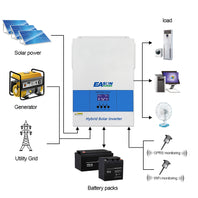The Basics of Solar Charge Controllers: A Beginner's Guide
Cuerpo
Are you new to the world of solar energy and looking to understand the fundamentals of solar charge controllers? Look no further! In this beginner's guide, we will delve into the essential aspects of solar charge controllers, providing you with a comprehensive understanding of their functionality and importance in solar power systems.

Understanding Solar Charge Controllers
Solar charge controllers, also known as solar regulators, are crucial components in off-grid solar power systems. Their primary function is to regulate the voltage and current coming from the solar panels to the battery and prevent overcharging. Additionally, they protect the batteries from over-discharge, ensuring their longevity and optimal performance.
Types of Solar Charge Controllers
There are two main types of solar charge controllers: PWM (Pulse Width Modulation) and MPPT (Maximum Power Point Tracking). PWM controllers are the traditional choice and are suitable for smaller systems with lower voltage solar panels. On the other hand, MPPT controllers are more advanced and efficient, capable of maximizing the power output from the solar panels, making them ideal for larger systems and areas with less than optimal sunlight conditions.
Key Features and Considerations
When selecting a solar charge controller for your system, there are several key features and considerations to keep in mind. These include the maximum input voltage and current rating, the type of battery it is compatible with (e.g., lead-acid, lithium-ion), temperature compensation, and the overall system voltage. It is essential to choose a controller that aligns with the specific requirements of your solar power setup to ensure optimal performance and longevity of the system.
Furthermore, some advanced solar charge controllers offer additional features such as remote monitoring, data logging, and programmable settings, providing users with greater control and insight into their solar power systems.
Installation and Maintenance
Installing a solar charge controller is a relatively straightforward process, but it is crucial to follow the manufacturer's guidelines and ensure proper wiring and connections. Regular maintenance, including inspecting the controller for any signs of wear and monitoring its performance, is essential to prolong its lifespan and the overall efficiency of the solar power system.
Conclusion
As you embark on your journey into the world of solar energy, understanding the role and functionality of solar charge controllers is paramount. By selecting the right controller for your system and ensuring its proper installation and maintenance, you can maximize the efficiency and longevity of your off-grid solar power setup.











Comentarios